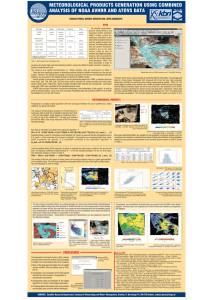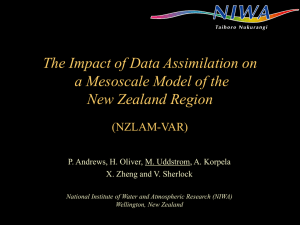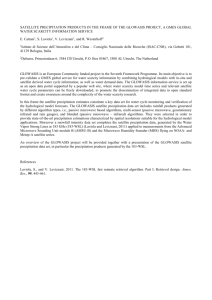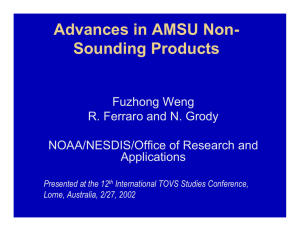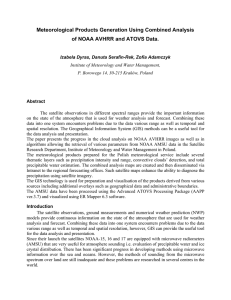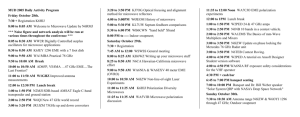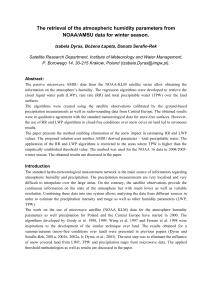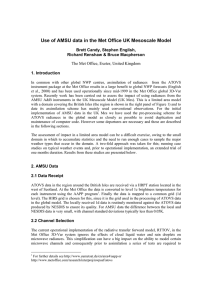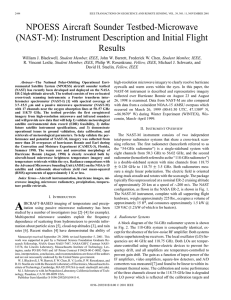Precipitation Estimation from NOAA/AMSU Data Izabela Dyras, Danuta Serafin-Rek INTRODUCTION
advertisement
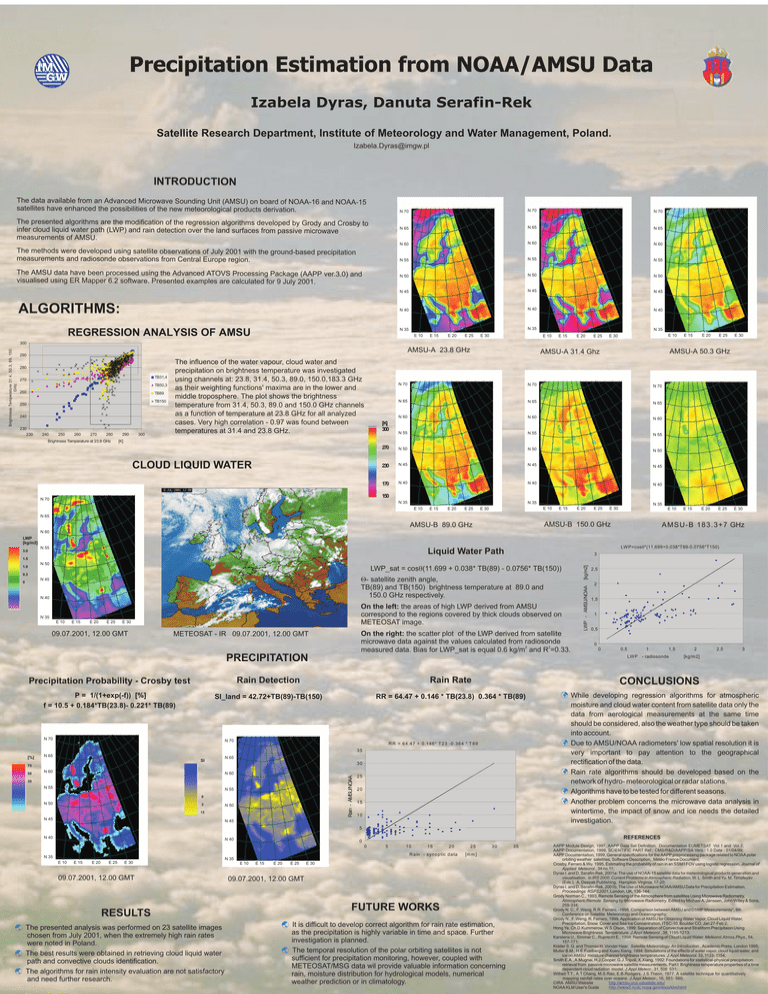
Precipitation Estimation from NOAA/AMSU Data Izabela Dyras, Danuta Serafin-Rek Satellite Research Department, Institute of Meteorology and Water Management, Poland. Izabela.Dyras@imgw.pl INTRODUCTION The data available from an Advanced Microwave Sounding Unit (AMSU) on board of NOAA-16 and NOAA-15 satellites have enhanced the possibilities of the new meteorological products derivation. The presented algorithms are the modification of the regression algorithms developed by Grody and Crosby to infer cloud liquid water path (LWP) and rain detection over the land surfaces from passive microwave measurements of AMSU. The methods were developed using satellite observations of July 2001 with the ground-based precipitation measurements and radiosonde observations from Central Europe region. The AMSU data have been processed using the Advanced ATOVS Processing Package (AAPP ver.3.0) and visualised using ER Mapper 6.2 software. Presented examples are calculated for 9 July 2001. ALGORITHMS: REGRESSION ANALYSIS OF AMSU N 70 N 70 N 70 N 65 N 65 N 65 N 60 N 60 N 60 N 55 N 55 N 55 N 50 N 50 N 50 N 45 N 45 N 45 N 40 N 40 N 40 N 35 N 35 N 35 E 10 Brightness Temperature 31.4, 50.3, 89, 150 GHz 300 E 15 E 20 E 25 E 30 E 10 AMSU-A 23.8 GHz 290 280 TB31,4 270 TB50,3 260 TB89 TB150 250 240 230 230 240 250 260 270 280 Brightness Temperature at 23.8 GHz 290 300 The influence of the water vapour, cloud water and precipitation on brightness temperature was investigated using channels at: 23.8, 31.4, 50.3, 89.0, 150.0,183.3 GHz as their weighting functions' maxima are in the lower and middle troposphere. The plot shows the brightness temperature from 31.4, 50.3, 89.0 and 150.0 GHz channels as a function of temperature at 23.8 GHz for all analyzed cases. Very high correlation - 0.97 was found between temperatures at 31.4 and 23.8 GHz. E 15 E 20 E 25 E 10 E 30 E 20 E 25 E 30 AMSU-A 50.3 GHz AMSU-A 31.4 Ghz N 70 N 70 N 70 N 65 N 65 N 65 N 60 N 60 N 60 N 55 N 55 N 55 270 N 50 N 50 N 50 230 N 45 N 45 N 45 170 N 40 N 40 N 40 N 35 N 35 N 35 [K] 300 E 15 [K] CLOUD LIQUID WATER 150 N 70 E 10 E 15 E 20 E 25 E 10 E 30 E 15 E 20 E 25 E 30 E 10 E 15 E 20 E 25 E 30 N 65 N 60 N 55 Liquid Water Path 1.5 N 50 1.0 Q- satellite zenith angle, TB(89) and TB(150) brightness temperature at 89.0 and 150.0 GHz respectively. N 45 0 3 LWP_sat = cosq(11.699 + 0.038* TB(89) - 0.0756* TB(150)) 0.3 N 40 N 35 E 10 E 15 E 20 E 25 On the left: the areas of high LWP derived from AMSU correspond to the regions covered by thick clouds observed on METEOSAT image. E 30 09.07.2001, 12.00 GMT On the right: the scatter plot of the LWP derived from satellite microwave data against the values calculated from radiosonde 2 2 measured data. Bias for LWP_sat is equal 0.6 kg/m and R =0.33. METEOSAT - IR 09.07.2001, 12.00 GMT PRECIPITATION AMSU-B 183.3+7 GHz LW P=cosq*(11,699+0,038*T89-0,0756*T150) [kg/m2] 3.0 LWP - AMSU/NOAA LWP [kg/m2] AMSU-B 150.0 GHz AMSU-B 89.0 GHz 2,5 2 1,5 1 0,5 0 0 0,5 1 1,5 LW P - radiosonde 2 2,5 3 [kg/m2] Precipitation Probability - Crosby test Rain Detection Rain Rate CONCLUSIONS P = 1/(1+exp(-f)) [%] f = 10.5 + 0.184*TB(23.8)- 0.221* TB(89) SI_land = 42.72+TB(89)-TB(150) RR = 64.47 + 0.146 * TB(23.8) 0.364 * TB(89) ü While developing regression algorithms for atmospheric moisture and cloud water content from satellite data only the data from aerological measurements at the same time should be considered, also the weather type should be taken into account. ü Due to AMSU/NOAA radiometers' low spatial resolution it is very important to pay attention to the geographical rectification of the data. ü Rain rate algorithms should be developed based on the network of hydro- meteorological or radar stations. ü Algorithms have to be tested for different seasons. ü Another problem concerns the microwave data analysis in wintertime, the impact of snow and ice needs the detailed investigation. N 70 [%] N 70 R R = 6 4.4 7 + 0.1 4 6 * T 2 3 -0 .3 6 4 * T 8 9 35 N 65 SI N 65 30 50 N 60 N 60 N 55 N 55 Rain - AMSU/NOAA 75 30 0 N 50 3 N 50 15 N 45 25 20 15 10 N 45 5 N 40 N 40 N 35 E 10 E 15 E 20 E 25 E 30 09.07.2001, 12.00 GMT RESULTS ý The presented analysis was performed on 23 satellite images chosen from July 2001, when the extremely high rain rates were noted in Poland. ý The best results were obtained in retrieving cloud liquid water path and convective clouds identification. ý The algorithms for rain intensity evaluation are not satisfactory and need further research. N 35 0 REFERENCES 0 5 10 15 20 R a in - syn o p tic d a ta E 10 E 15 E 20 E 25 25 30 [m m ] E 30 09.07.2001, 12.00 GMT FUTURE WORKS ý It is difficult to develop correct algorithm for rain rate estimation, as the precipitation is highly variable in time and space. Further investigation is planned. ý The temporal resolution of the polar orbiting satellites is not sufficient for precipitation monitoring, however, coupled with METEOSAT/MSG data wil provide valuable information concerning rain, moisture distribution for hydrological models, numerical weather prediction or in climatology. 35 AAPP Module Design, 1997, AAPP Data Set Definition, Documentation EUMETSAT Vol.1 and Vol.2; AAPP Documentation, 1999, SCIENTIFIC PART Réf.: CMS/R&D/AAPP/SA Vers.: 1.0 Date : 01/04/99; AAPP Documentation, 1999, General specifications for the AAPP preprocessing package related to NOAA polar orbiting weather satellites, Software Description, Météo France Document; Crosby, Ferraro & Wu 1995, Estimating the probability of rain in an SSM/I FOV using logistic regression, Journal of Applied Meteorol., 34 no.11; Dyras I. and D. Serafin-Rek, 2001a: The use of NOAA-15 satellite data for meteorological products generation and visualisation. in IRS 2000: Current Problems in Atmospheric Radiation, W. L. Smith and Yu. M. Timofeyev (Eds.). A. Deepak Publishing, Hampton, Virginia, 17-20; Dyras I. and D. Serafin-Rek, 2001b, The Use of Microwave NOAA/AMSU Data for Precipitation Estimation, Proceedings RSPS2001, London, UK, 136-144; Grody Norman C., 1993, Remote Sensing of the Atmosphere from satellites Using Microwave Radiometry, Atmospheric Remote Sensing by Microwave Radiometry, Edited by Michael A. Janssen, John Willey & Sons, 259-334; Grody N. C., F. Weng, R.R. Ferraro, -1998, Comparison between AMSU and DSMP Measurements", 9th Conference on Satellite Meteorology and Oceanography; Grody N., F. Weng, R. Ferraro, 1999, Application of AMSU for Obtaining Water Vapor, Cloud Liquid Water, Precipitation, Snow Cover and Sea Ice Concentration, ITSC-10, Boulder CO, Jan 27-Feb 2; Hong Ye, Ch.D.Kummerow, W.S.Olson, 1999: Separation of Convective and Stratiform Precipitaion Using Microwave Brightness Temperature. J.Appl.Meteorol., 38, 1195-1213; Karstens U., Simmer C., Ruprecht E., 1994: Remote Sensing of Cloud Liquid Water. Meteorol.Atmos.Phys., 54, 157-171; Kidder S. Q. and Thomas H. Vonder Haar, Satellite Meteorology. An Introduction., Academic Press, London 1995; Muller B.M., H.E.Fuelberg and Xuwu Xiang, 1994: Simulations of the effects of water vapor, cloud liquid water, and ice on AMSU moisture channel brightness temperatures. J.Appl.Meteorol. 33, 1133- 1154; Smith E.A., A.Mugnai, H.J.Cooper, G.J.Tripoli, X.Xiang, 1992: Foundations for statistical-physical precipitation retrieval from passive microwave satellite measurements. Part I: Brightness temperature properties of a time dependent cloud radiation model. J.Appl.Meteor., 31, 506 531; Wilheit T.T., A.T.Chang, M.S.Rao, E.B.Rodgers, J.S.Theon, 1977: A satellite technique for quantitatively mapping rainfall rates over oceans. J.Appl.Meteor., 16, 551- 560; http://amsu.cira.colostate.edu/ CIRA AMSU Website http://www2.ncdc.noaa.gov/docs/klm/html NOAA KLM User's Guide
